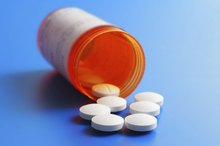Suboxone & Weightlifting
Suboxone is an oral medication used to treat opiate addiction 2. It consists of a combination of buprenorphine and naloxone. Buprenorphine is a half opiate agonist -- or activating agent -- similar to codeine or morphine. It is what gives suboxone its own addictive properties. Naloxone blocks the effects of other opiates in your system. Weight lifting provides individuals taking suboxone a therapeutic outlet from drug-induced symptoms.
If you are experiencing serious medical symptoms, seek emergency treatment immediately.
Staying Sexy
A common side effect of suboxone is impotence, or sexual dysfunction. This negative aspect of suboxone treatment has caused some men to stop taking suboxone. However, you can boost your libido by increasing your testosterone levels through weightlifting. Twenty to 40 reps per workout is sufficient to achieve desired benefits without running the risk of overdoing it, which can actually decrease testosterone levels. Maintaining a healthy sex life can increase your self-esteem and help you stay on track with your suboxone program.
- A common side effect of suboxone is impotence, or sexual dysfunction.
- Maintaining a healthy sex life can increase your self-esteem and help you stay on track with your suboxone program.
Pumping Iron
Side Effects of Taking Wellbutrin and Celexa
Learn More
Suboxone treatment can cause rapid and drastic weight loss. Men and women have been known to drop 20, 30 or 40 pounds in a short time period. While losing weight is sometimes desired, this type of weight loss can interfere with a healthy body composition. Instead of unhealthy fat, most of the weight you lose is through diminished muscles. By weight training you can gain muscle tissue, offsetting the effects of suboxne.
- Suboxone treatment can cause rapid and drastic weight loss.
- Instead of unhealthy fat, most of the weight you lose is through diminished muscles.
Finding a Happy Place
Endorphins are chemicals produced in the brain by the pituitary gland. As the body's natural pain killer and mood elevator, endorphins are released to reduce physical pain. The stress of intense exercise, such as weight lifting, increases the production of endorphins, resulting in a natural happy mood. Reducing anxiety and depression through endorphin release while weightlifting can help you sustain your suboxone program and help you achieve your sobriety goals.
- Endorphins are chemicals produced in the brain by the pituitary gland.
- The stress of intense exercise, such as weight lifting, increases the production of endorphins, resulting in a natural happy mood.
Sleeping Yourself Well
Sexual Side Effects of Ambien
Learn More
Weightlifting can help you with the side effects when you discontinue suboxone at the end of your treatment program. One frequently experienced withdrawal symptom is insomnia. A lack of sleep can lead to emotional weakness and poor health, not conducive for remaining sober and well. Weightlifting can help you remain strong emotionally and physically, because intense exercise rids your body of stress chemicals and helps you relax. Relaxation of body and mind induces sound sleep.
- Weightlifting can help you with the side effects when you discontinue suboxone at the end of your treatment program.
- Weightlifting can help you remain strong emotionally and physically, because intense exercise rids your body of stress chemicals and helps you relax.
Related Articles
References
- "Substance Abuse and Recovery Workbook" ; John J. Liptak ; 2008
- "Men and Addictions: New Research (Substance Abuse Assessment, Interventions and Treatment) ; 2009
- The Harvard Medical School Family Health Guide: Treating Opiate Addiction, Part I: Detoxification and Maintenance
- Reuters. "Indiana HIV outbreaks tops 100 cases: state health officials." Issued April 11, 2015.
- U.S. Food and Drug Administration. "Highlights of Prescribing Information: SUBOXONE (buprenorphine and naloxone) sublingual film, for sublingual or buccal use CIII." Silver Spring, Maryland; October 8, 2002; updated February 2017.
- Woody, G.; Poole, S.; Subramaniam, G.; et al. "Extended vs Short-term Buprenorphine-Naloxone for Treatment of Opioid-Addicted Youth: A Randomized Trial." JAMA. 2008; 300:2003-2011.
Writer Bio
Based in New York, John Tavolacci has been a leading exercise physiologist for over 14 years. His resume includes stints in cardiac rehab, sports conditioning, physical therapy and corporate wellness. He is a certified health/fitness instructor and a certified strength and conditioning specialist. Tavolacci also holds a master's degree in exercise physiology from Queens College.









